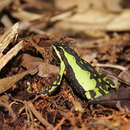Comprehensive Description
provided by Smithsonian Contributions to Zoology
Atelopus pulcher pulcher (Boulenger)
Phryniscus pulcher Boulenger, 1882:154, pl. 13: fig. 2 [type locality: “Chyavetas, Peru” perhaps the same as Chayahuitas, Peru, according to Rivero, 1968:19)].
Atelopus pulcher.—Boulenger, 1894:375.—Peracca, 1904:22.—Rivero, 1963:107.
Atelopus spumarius.—Rivero, 1968:19.
Atelopus spumarius spumarius.—Duellman and Lynch, 1969:232.
SYNTYPES.—Four individuals in the British Museum (Natural History), and USNM 193574.
DESCRIPTION.—Snout from above rounded from nostril to nostril, canthus forms a straight line from nostril to eye, little or no fleshy area on snout region or on canthus. Dorsum of head flat, smooth, slight knob at corner of skull. Snout from side very slightly protrusive beyond upper lip and lower jaw; nostril directed laterally. Loreal region vertical; upper eyelid slightly fleshy, overhangs eye; upper lip not fleshy; temporal and tympanic areas smooth or very lightly wrinkled and shagreened. No tubercular areas on head, body, or limbs. Dorsum and sides of body lightly wrinkled, belly wrinkling somewhat more pronounced.
Forelimb slender and slightly wrinkled, forearm usually thicker than humeral region. When forelimb is drawn back along body, palm reaches thigh. Palm of hand fleshy; first digit distinct, with tip of digit free of fleshy webbing; other digits entirely free of webbing; subarticular tubercles very indistinct; palmar tubercle very large, rounded.
Hind limb slender, smooth or finely wrinkled, under surfaces of thighs below anus with markedly wrinkled and somewhat pustulate area, usually distinctively colored. Tibiotarsal articulation reaches points between anterior and posterior margins of eye; heels touch or overlap when tibiofibulae are parallel to femora at right angles to body. Entire foot somewhat fleshy, with first digit entirely hidden in webbing, second with only its tip protrusive, other three digits webbed to tip, on fourth chiefly as fringe. Subarticular swellings present; outer metatarsal tubercle present but small.
COLOR IN ALCOHOL.—Dorsal ground color greenish yellow, with dark brown vermiculations and spotting more or less symmetrically distributed on head, back and sides; upper lip yellow, with a fine brown line along margin. Belly and chin yellow, with small rounded brown spots primarily located posteriorly. Limbs barred above with dark brown, yellow below with brown spotting. Soles of feet and area just below anus flesh colored.
COLOR IN LIFE.—Dorsal ground color yellowish green, with jet black spotting and striping. Soles of feet bright red, with area on venter that is flesh colored in alcohol also bright red. In some individuals the entire ventral surface is red.
- bibliographic citation
- Peters, James Arthur. 1973. "The frog genus Atelopus in Ecuador (Anura: Bufonidae)." Smithsonian Contributions to Zoology. 1-49. https://doi.org/10.5479/si.00810282.145
Atelopus pulcher: Brief Summary
provided by wikipedia EN
Atelopus pulcher is a species of toad in the family Bufonidae. It is endemic to eastern Peru where it is found in the Huallaga River drainage; its range might extend to Ecuador. Its natural habitats are lowland and premontane tropical forests. It is a diurnal and terrestrial species that breeds in streams.
- license
- cc-by-sa-3.0
- copyright
- Wikipedia authors and editors

